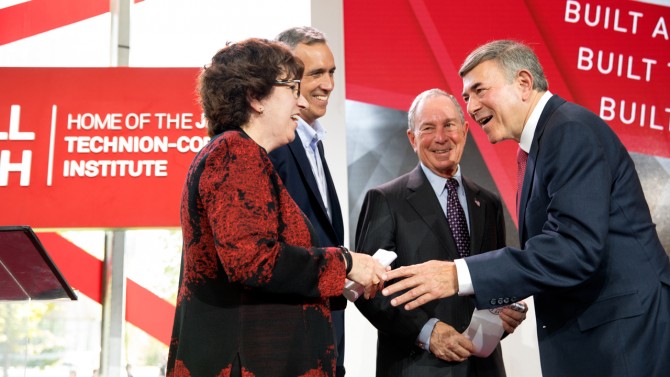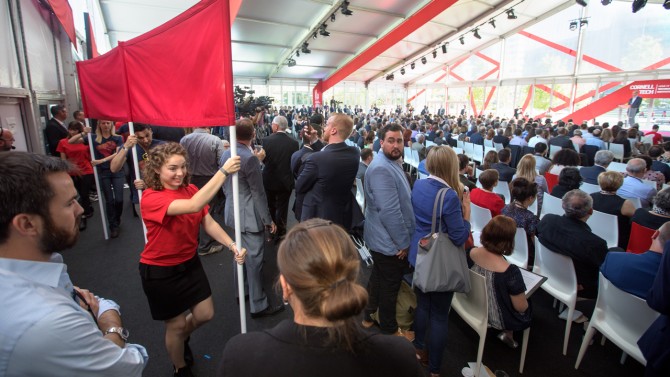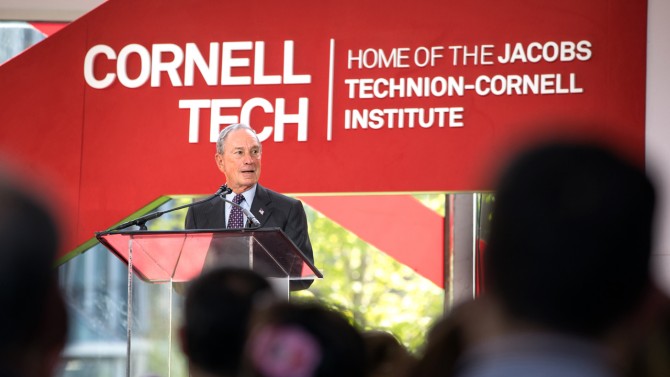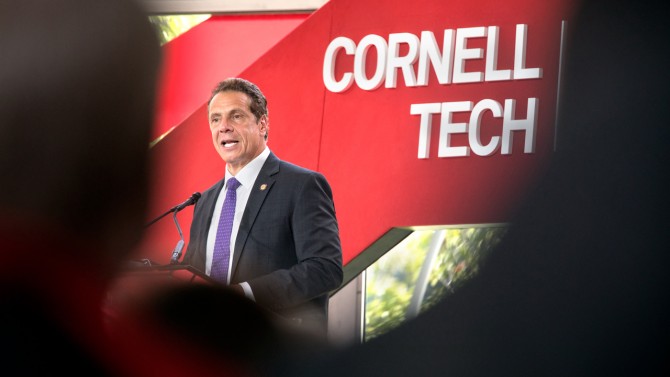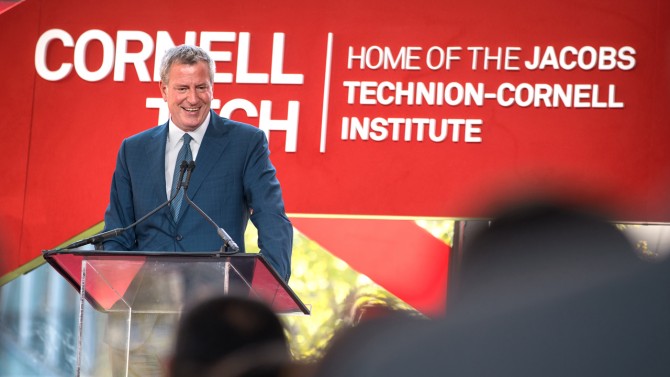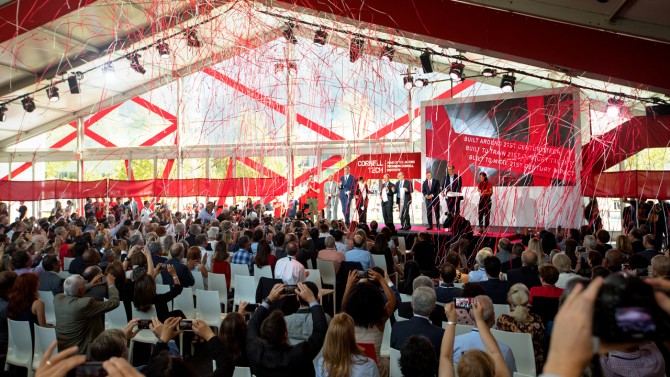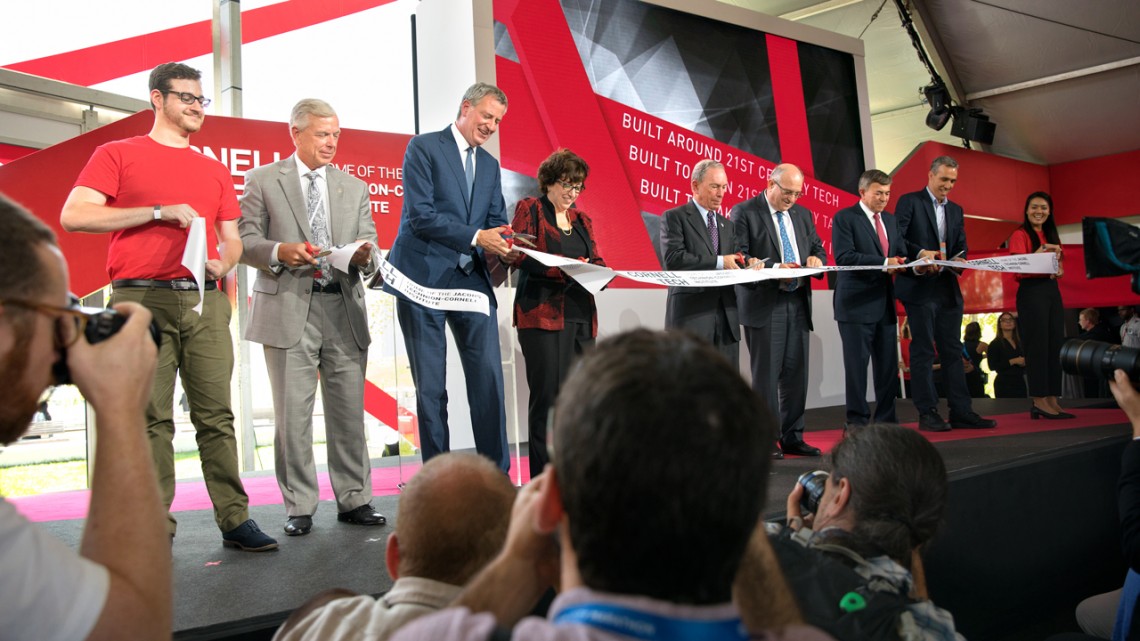
Onstage for the ribbon-cutting officially dedicating the Cornell Tech campus Sept. 13 are, from left, Cornell Tech student Evan Kesten, M.S. ’18, Verizon Communications Chairman and CEO Lowell McAdam, New York City Mayor Bill de Blasio, Cornell President Martha E. Pollack, philanthropist and former NYC Mayor Michael Bloomberg, Technion President Peretz Lavie, Cornell Board of Trustees Chairman Robert Harrison, Dean and Vice Provost Dan Huttenlocher, and Cornell Tech student Jillian Sue, M.S. ’18.
‘Revolutionary’ Cornell Tech campus in NYC dedicated
By Tom Fleischman
Cornell has been called the first truly American university by virtue of founder Ezra Cornell’s vision of “an institution where any person,” regardless of race, gender, background or means, “can find instruction in any study.”
The idea was positively revolutionary at Cornell’s founding in April 1865, and revolutionary is none too strong a descriptor for Cornell’s newest and perhaps boldest idea: a “transformative” campus in the heart of New York City, with its sights set on a tech-oriented, digitally driven future.
With luminaries and Cornell power players aplenty, and pomp-and-circumstance befitting such a historic occasion, Cornell officially strengthened its already sizable New York City presence Sept. 13 with the dedication of the glittering, futuristic Cornell Tech campus on Roosevelt Island.
“In academic terms, Cornell Tech has been created in record time – from vision to reality in just a few short years,” said Cornell President Martha E. Pollack. “In another way, Cornell Tech has been a long time in the making – building on a century of Cornell teaching, research, patient care and service to New York City and tracing back to our land-grant roots.
“Yet this moment is more than just a continuation; it’s a transformation – for Cornell and for New York City,” she said. “And I believe that Cornell Tech will be transformative in every way.”
Less than six years after winning then-New York City Mayor Michael R. Bloomberg’s contest to submit plans for an applied sciences and engineering campus, Cornell Tech is up and running. The winning proposal that spawned Cornell Tech was a joint submission, Cornell partnering with the Technion – Israel Institute of Technology.
Phase One of the three-phase construction process is near completion, and academic activity began last month on the sparkling, sustainability-driven campus. Completion of the full campus is expected in 2043.
Robert S. Harrison ’76, chair of the Cornell University Board of Trustees and another driving force in making the day possible, put it in perspective.
“I have been actively involved with Cornell since I was an undergraduate more than 40 years ago,” he said, “and I can say – with both confidence and awe – that this is the single biggest Cornell event I have witnessed in those 40-plus years. Cornell Tech is both completely transformative and completely consistent with Cornell’s mission and values, going all the way back to the university’s founding in 1865.
“If Ezra Cornell were alive today,” Harrison said, “he would be Cornell Tech’s biggest supporter.”
The dedication – held in a massive climate-controlled tent on the campus lawn – began with a short introductory video, followed by a welcome from Cornell Tech’s founding dean and vice provost, Dan Huttenlocher, who was recently named the Jack and Rilla Neafsey Dean of Cornell Tech. During his remarks, he explained the significance of the day’s theme: the partnership between Cornell Tech and the community.
That bond was represented by four community pillars – interconnections between academia and industry; economic development; New York City; and institutional leadership – and carnelian banners that linked them and the university together.
As former Mayor Michael Bloomberg, New York Gov. Andrew Cuomo, Mayor Bill de Blasio and Harrison took the stage to deliver their respective remarks, community leaders representing each of the four pillars carried long banners in front of the stage and handed them to students offstage.
“The connective thread through all of this is tremendous dedication, and many of the ribbon-bearers are those who’ve shown that dedication,” Huttenlocher said. “That has enabled us to develop this project at warp-speed, even by industry standards, much less a partnership between academia and government, which this campus is.”
Bloomberg began by thanking Cuomo and de Blasio, as well as his former administrative team, which came up with the idea in December 2010 for the competition that resulted in the Tech campus.
“Cornell Tech is the result of collaboration between public and private sectors, between universities and businesses, artists and architects, and so many others,” he said.
He touched on the architecture of the Bloomberg Center, the academic building for which his Bloomberg Philanthropies made a $100 million donation in 2015, and which is named for his daughters, Emma and Georgina.
“[The Bloomberg Center] is intended to spur collaboration,” he said. “That’s why there are very few walls in the building, and where they exist, they are often transparent. This may be the only university building in the world with no private offices for professors. And that is a feature, not a bug.”
Bloomberg – who six years ago had a vision of New York becoming a global force in technology innovation, and a place that would educate entrepreneurs and create jobs of and for the future – reaffirmed that confidence.
“This [campus] is an investment in the future of New York City – a future that belongs to the generations to come, and the students who will help build it,” said Bloomberg, who reminded the gathering of the city’s history as a birthplace of such innovations as the first commercial steamboat, the first power plant, the telegraph, the cellphone and the ATM machine.
“The companies they create will generate jobs for people across the economic spectrum,” he said, “and will generate revenue that will help our city pay for vitally important services, and they will help our city compete with tech centers around the world, from Silicon Valley to Seoul.”
Cuomo – who called the opening of Cornell Tech “an extraordinary singular achievement” and a “powerful symbol of possibility” – called the campus a key player as New York City extends its leadership in science and tech.
“Today shows the intelligent way forward, and the ability to achieve it,” Cuomo said. “The truth is this: An economy that does not invest today in the industries of tomorrow is destined to be trapped in the jaws of yesterday. In New York, we know that our future is what we make it. We know what needs to be done, and we are doing it.
“It’s about investing in science and technology, not just as an economic strategy but as a way to improve the quality of life. These are our north stars, our guideposts. Mayor Bloomberg helped chart the course, and now New York leads the way. Cornell Tech, welcome to New York. You embody the Roosevelt spirit of possibility,” he said, referring to Franklin Delano Roosevelt, namesake of the island.
Pollack then briefly took the podium to introduce de Blasio, who succeeded Bloomberg in 2014 and whose leadership kept the Tech campus momentum alive. The current mayor – in what he admitted was an extreme rarity – tipped his cap to his predecessor in officially welcoming Cornell Tech to its new home.
“We are here because of one person, who had a vision and had the persistence to believe that this could happen,” de Blasio said. “And I want to say to Mike Bloomberg a profound thank you, on behalf of 8-and-a-half million New Yorkers who are better for what you did.”
De Blasio invoked the famous line from the movie “Field of Dreams” – “If you build it, they will come” – in describing the excitement Cornell Tech has and will generate.
“This institution says to people that we will be forever a global center of technology and innovation,” he said. “There was lots of evidence in the past that we had all those great attributes, but something was missing. Something had to be that exclamation point … and this became that exclamation point.”
De Blasio noted that the tech “ecosystem” in New York City now includes 350,000 employees and is “growing rapidly.” And as Cuomo also noted, diversity and inclusion are central to Cornell Tech and the city itself.
“We as New Yorkers bristle when we feel there’s talk of exclusion – it doesn’t fit with our experience,” said de Blasio, who often delivers speeches in fluent Spanish. “It’s the ultimate city of immigrants. … We’ve always tended to live and let live and accept all sorts of people who brought something to the equation. This has worked for New York City … and what we have here is a living, breathing answer to anyone who sees exclusion. We are proving every day that inclusion works.
“I want to say to everyone a heartfelt congratulations,” he said. “You’re doing something that will make this city profoundly better and will give hope to so many people across the five boroughs.”
Next to speak was Harrison, who called Cornell Tech “a natural 21st-century expression of the university’s founding principles” and its land-grant mission.
“Cornell was founded with a deep commitment to serve the people of New York state,” he said, “by developing knowledge that benefits not only communities within the state, but also around the world. More than 150 years later, outreach and engagement remain critical parts of our identity.”
That includes Cornell Tech, whose master’s curricula includes a heavy dose of engagement with the community and the business world.
Harrison reminded the gathering – along with thousands who watched the ceremony via livestream in Ithaca and elsewhere – that Cornell’s roots in New York City run deep.
“Our first step was the establishment of the Cornell College of Medicine [now Weill Cornell Medicine] in Manhattan in 1898,” Harrison said, “which today is an internationally recognized research, teaching and clinical care provider with reach and impact throughout New York City.”
Harrison added that Cornell’s New York City footprint was already sizable, but when the call went out in 2011 for proposals for a new applied science and tech campus, Cornell’s response was “immediate and overwhelming.”
“We knew we had to win this competition – there was simply no alternative,” he said, citing the leadership of then-president David Skorton, the board of trustees and Charles H. Feeney ’56, whose $350 million gift provided much of the momentum for Phase One construction. The humble billionaire, who made the gift anonymously but was identified in the press days later, was represented at the ceremony by his daughter, Juliette Feeney.
Next to the podium was Pollack, whose background is in computer science and artificial intelligence. Cornell’s 14th president cited three examples – graduate education for the digital age, pairing academia and industry, and sustainability – that illustrate the transformational nature of Cornell Tech.
Regarding the digital age: “There are no disciplinary silos. Every one of our master’s students spends one-third of their time working in our studio curriculum, creating products and solving problems – engineering students with business students with law students with computing and information science students. The best way to solve our biggest challenges is to gather a diversity of voices, backgrounds and disciplines.”
Regarding forging bonds with industry: “We are assembling some of the finest research teams on the planet, and what excites me is that their research will be put to use immediately in the real world. Companies are a permanent part of the campus, ensuring collaboration that accelerates commercial innovation.”
And regarding sustainability: “This beautiful campus is one of the most sustainable in the world, introducing net-zero and passive house standards to New York. Our residential building [The House] was the first high-rise in the world built to passive house standards, but it has already inspired an even taller building planned across the river in East Harlem. That is the transformative role we want to play.”
She called the new campus a “special place” that is “designed to be different,” and looked ahead nearly 30 years to the time when Cornell Tech is scheduled to be fully complete. “I can’t tell you yet what the next buildings will look like,” she said, “but I can promise you that both in the buildings themselves and in the work they will house, we will continue to build on the same pillars that define this campus and have defined Cornell for more than 150 years.”
Following Pollack was Technion President Peretz Lavie, who recalled Bloomberg approaching him with the idea back in 2011.
“A once-in-a-generation opportunity to build a new university in New York City – those were the words of Mayor Bloomberg in his invitation,” Lavie said. “I used these words in conveying this magnificent idea to a group of Technion deans. I asked them to prepare a proposal for a new program in New York, tailor-made for the economic strength of the city.
“Between you and me, I told them, since we have such a slim chance of winning, be wild!” he added with a smile. “Use your imagination. Think out of the box. And indeed, they did.”
Lavie called the dedication “the beginning of a new chapter” in the work that began in 2012 with the launch of Cornell Tech, which spent its first four academic years in the Google building in the Chelsea neighborhood of Manhattan.
“In partnership with Cornell,” Lavie said, “we’ve developed a model of graduate-level technology education that is unlike any other – one that’s tailor-made not only for New York City but for the challenges of the digital revolution. … The campus we inaugurate today was built for the future,” he said. “It will generate the next new ideas, new companies and talent that will fulfill Mayor Bloomberg’s vision for New York City. Our students will become immediate players in the fourth industrial revolution and will join New York’s vibrant economy.”
After the final speech, the VIPs were invited back on stage for the ceremonial ribbon-cutting. A white ribbon adorned with the Cornell Tech logo was stretched across the stage, and following a drum roll and countdown, the ribbon was cut as confetti cannons shot streamers into the air.
Cornell Tech officially was declared open – for academia, as well as for business.
Media Contact
Get Cornell news delivered right to your inbox.
Subscribe